Equipment
Music is a lifelong hobby that I see worthy of investment. Every instrument I've acquired comes with a story. I've accumulated a bit of equipment over the years. Don't be discouraged if you're working on a limited budget! I started small and worked my way up as my skills and my budget allowed.
Instruments
I was a barista at La Dolce Vita coffee in Olde Town Arvada, Colorado when I realized that I wanted to play the mandolin. I started mentioning my interest in the mandolin to my customers in casual conversation. One day, while chatting with my friend Steve, the mandolin conversation came up. Steve mentioned that his wife bought him a mandolin that he never played. I asked him if he'd be willing to sell it. My first mandolin was a Fender FM-100, purchased for $100. I played the heck out of that thing. I took it home and practiced every day, playing until my fingers couldn't take it any more. There was so much about the mandolin that I needed to learn, so many skills I needed to develop in order to get better. Playing the mandolin was like being consistently challenged, being met with a wall, and working to scale each wall I met on my way to the next. I was hooked. It came with a soft case with backpack straps, and I carried it with me everywhere.
After I bought my second mandolin I left the Fender hanging on the wall at La Dolce Vita to be enjoyed by the community. It may still be there! If you ever visit I want you to pull it off the wall, tune it up, and play a quick tune. Be sure you play it with love, and put it back when you're done.
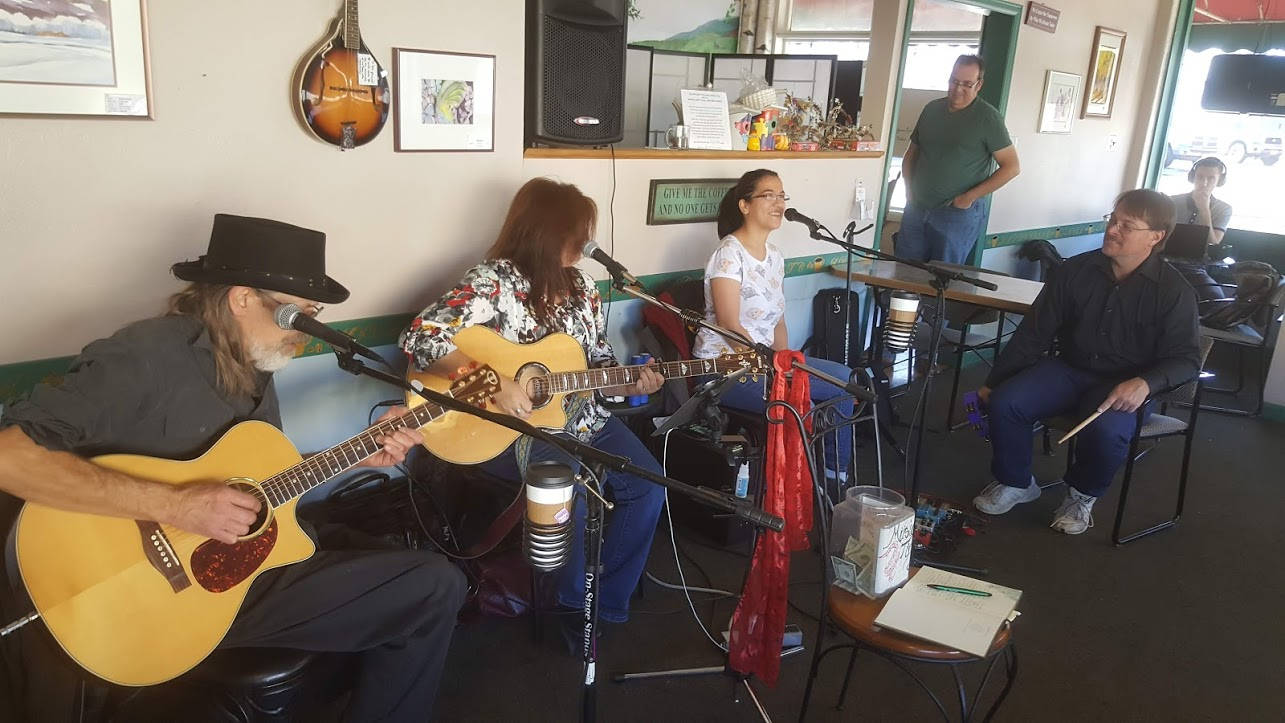
My main mandolin is a Collings MF. It's got a honey amber finish, a gloss top, satin back and sides, with tortoise binding. I picked it up at the Olde Town Pickin' Parlor in Arvada, Colorado. I used to go in that shop nearly every day to play all their mandolins. I fell in love with four mandolins that passed through their doors - Nugget #149, a beautiful Collings MF5-V with an engraved tailpiece, my main mandolin, and my old mandolin, which I'll discuss below. I owe a great deal of gratitude to Kit Simon for helping foster my love of the mandolin, as well as to Liz Forster for putting up with the countless hours of my playing and lusting over instruments I couldn't afford. After pulling it off the wall and playing it, I knew it was the instrument for me. I scrounged everything I could save from that day forward in the hopes that it'd still be there when I could afford it. In the year that followed I had switched jobs and moved across the country. I came back to town for a visit over the Thanksgiving holiday and made a point to drop by the shop. I walked right up to the mandolin wall, saw it was there, and brought it down off the wall. I was so grateful that it was still there when I came back to buy it. Some things are meant to be.
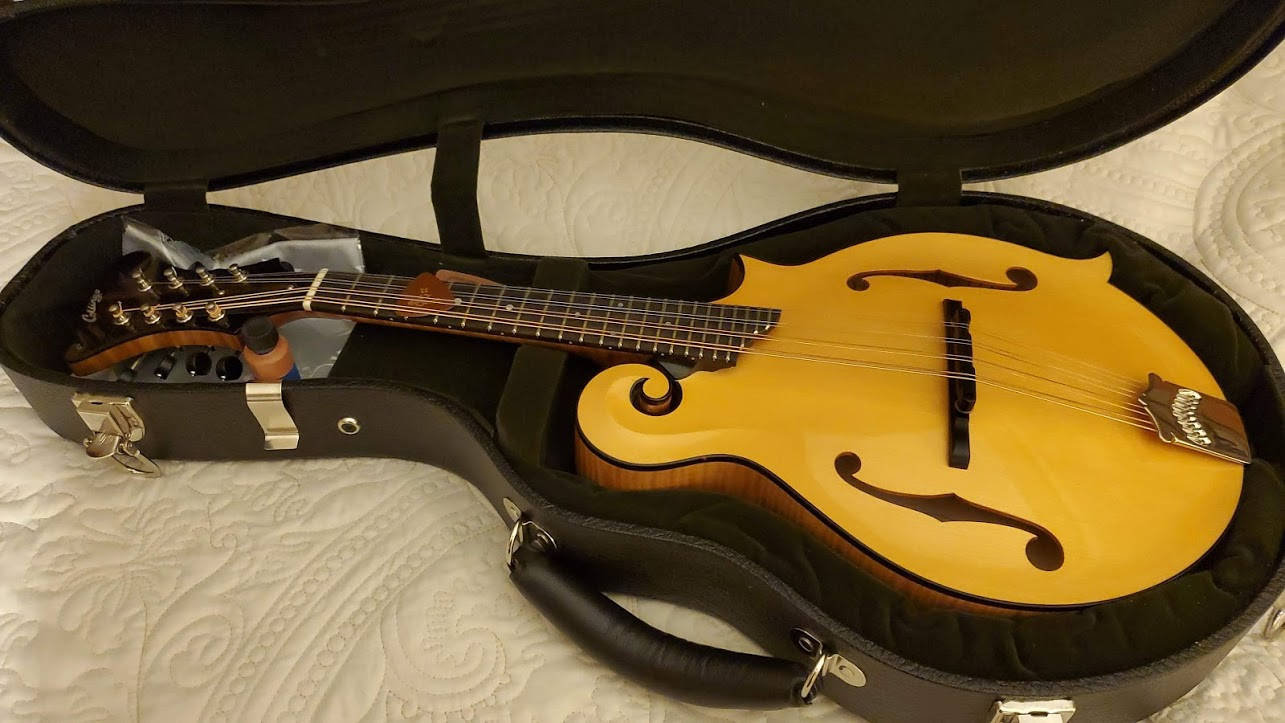
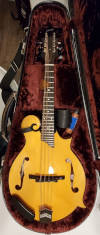 I store my main mandolin in a grey Calton case I bought used. It's old, it's heavy, it's absolutely covered in stickers, and I'd trust my mandolin to survive if I ever had to throw it off a building. The Calton conveniently doubles as a bludgeoning tool to fight off would-be attackers. I've also attached a McClung armrest to it the mandolin. I find the armrest helps my picking arm have a better angle of attack, and it alleviates the edge of the binding from digging into my wrist. I have a Long Hollow Leather soft strap attached to it as well, which I love when I play standing up. I have a Tone-Guard installed on the back of my main mandolin. The Tone-Guard is a hotly-contested accessory that some people swear by and other people hate. Personally, I can tell the difference it makes by keeping the mandolin back free of my belly when I play standing. It does nothing when I play sitting, as the back of the mandolin is already free. Since I play in both positions I leave it on my mandolin all the time. I keep an Oasis humidifier in each of my cases, and I top them up roughly weekly during the winter months as needed. I prefer Blue Chip CT-55 picks, but they're pretty pricy. I don't lose picks, probably because of the replacement expense! Amusingly, the CT-55 has exactly the same shape , thickness, and bevel as a Dunlop Primetone 1.4 which is much more affordable. I keep one of those in my wallet as an emergency pick, and I store the Blue Chips tucked between the fretboard and the strings of my mandolins.
I store my main mandolin in a grey Calton case I bought used. It's old, it's heavy, it's absolutely covered in stickers, and I'd trust my mandolin to survive if I ever had to throw it off a building. The Calton conveniently doubles as a bludgeoning tool to fight off would-be attackers. I've also attached a McClung armrest to it the mandolin. I find the armrest helps my picking arm have a better angle of attack, and it alleviates the edge of the binding from digging into my wrist. I have a Long Hollow Leather soft strap attached to it as well, which I love when I play standing up. I have a Tone-Guard installed on the back of my main mandolin. The Tone-Guard is a hotly-contested accessory that some people swear by and other people hate. Personally, I can tell the difference it makes by keeping the mandolin back free of my belly when I play standing. It does nothing when I play sitting, as the back of the mandolin is already free. Since I play in both positions I leave it on my mandolin all the time. I keep an Oasis humidifier in each of my cases, and I top them up roughly weekly during the winter months as needed. I prefer Blue Chip CT-55 picks, but they're pretty pricy. I don't lose picks, probably because of the replacement expense! Amusingly, the CT-55 has exactly the same shape , thickness, and bevel as a Dunlop Primetone 1.4 which is much more affordable. I keep one of those in my wallet as an emergency pick, and I store the Blue Chips tucked between the fretboard and the strings of my mandolins.
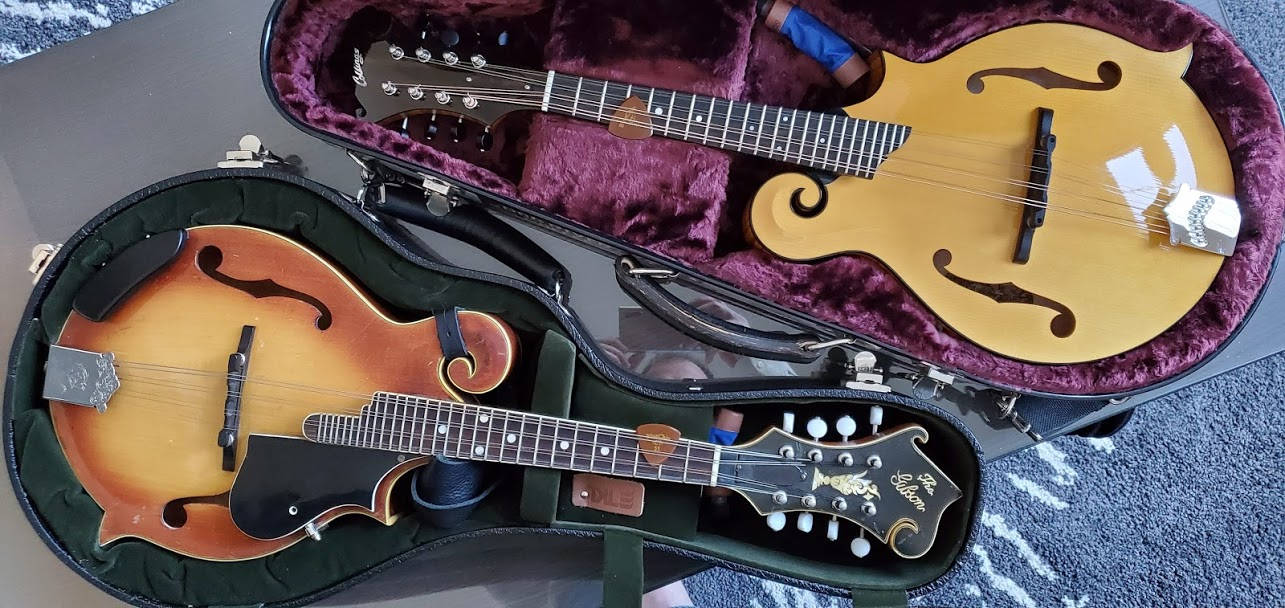
My old mandolin I also picked up at the Olde Town Pickin' Parlor. Kit called it a "sorta-Gibson" and Liz said it was for people who "wanted the look without the price". It's a handmade homage to the 'teens Gibson Master Model that I'm fairly certain was made out of a chair someboy didn't like. It's heavy and not particularly well made, but it's got mojo and I played the heck out of it. I had Micah Lundy at the Olde Town Pickin' Parlor repair shop install a K+K Mandolin Twin pickup at their shop and I played a ton of open mics with it. The old mandolin is my preferred mandolin for gigging. It's heavy, beefy, has a pickup installed, and I wouldn't cry if it got some beer spilled on it. It's already had a fair share of coffee.

My fancy fiddle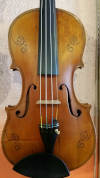 is an old no-name instrument with a twisted history. Back when I owned a coffee shop I made a regular point to stop by Von's Violin Shop when Von was located in the old South Pearl Street neighborhood in Denver. I had a rent-to-own violin at the time and was always on the hunt for a step-up instrument. One day, hanging front and center on the wall behind the counter, I saw the fancy fiddle. I was drawn to the ornate inlaid purfling, the clean swooping lines, and all the tell-tale marks of an instrument with a lot of history. I put a pitifully small down payment on it to hold it. Every week I took some of my tip money and put it towards the violin. It was a few years before I could take it home. I don't know who made it, or how old it is, but I do know that in the early 1900's the previous owner slipped on some ice and shattered it - the front plate was in numerous pieces and the neck had broken inward onto itself. The violin was taken to the shop of Joseph Settin in New York to be repaired and Joseph managed to piece it together immaculately. Countless cleats inside the front plate bind each of the cracks, and the neck was re-set into the body with only minor damage to the decorative purfling on the joint. Yet, for all the repairs, it sounds and plays like a soloist's instrument.
is an old no-name instrument with a twisted history. Back when I owned a coffee shop I made a regular point to stop by Von's Violin Shop when Von was located in the old South Pearl Street neighborhood in Denver. I had a rent-to-own violin at the time and was always on the hunt for a step-up instrument. One day, hanging front and center on the wall behind the counter, I saw the fancy fiddle. I was drawn to the ornate inlaid purfling, the clean swooping lines, and all the tell-tale marks of an instrument with a lot of history. I put a pitifully small down payment on it to hold it. Every week I took some of my tip money and put it towards the violin. It was a few years before I could take it home. I don't know who made it, or how old it is, but I do know that in the early 1900's the previous owner slipped on some ice and shattered it - the front plate was in numerous pieces and the neck had broken inward onto itself. The violin was taken to the shop of Joseph Settin in New York to be repaired and Joseph managed to piece it together immaculately. Countless cleats inside the front plate bind each of the cracks, and the neck was re-set into the body with only minor damage to the decorative purfling on the joint. Yet, for all the repairs, it sounds and plays like a soloist's instrument.
My second fiddle quite literally came through the front door and landed in my lap. My good friend Jack from Lucky Jack's Antiques on South Broadway in Denver brought it and another violin into my coffee shop for me to look at. He had consigned them and was curious what I thought they were worth. My then-partner told me to do whatever it took to buy it. I brought it to Von to learn more about it. It's a copy of a copy of a Stradivarius, made in the mid 1800's, and most likely a German trade instrument. I brought the news back to Jack. I gathered all the money I could afford at the time and I bought it then and there. It's a wonderful instrument and it's very forgiving to play. It's seen many years of love and had countless hours of beautiful music played through it. To this day I consider the purchase of this violin to be one of the best deals I've ever made.
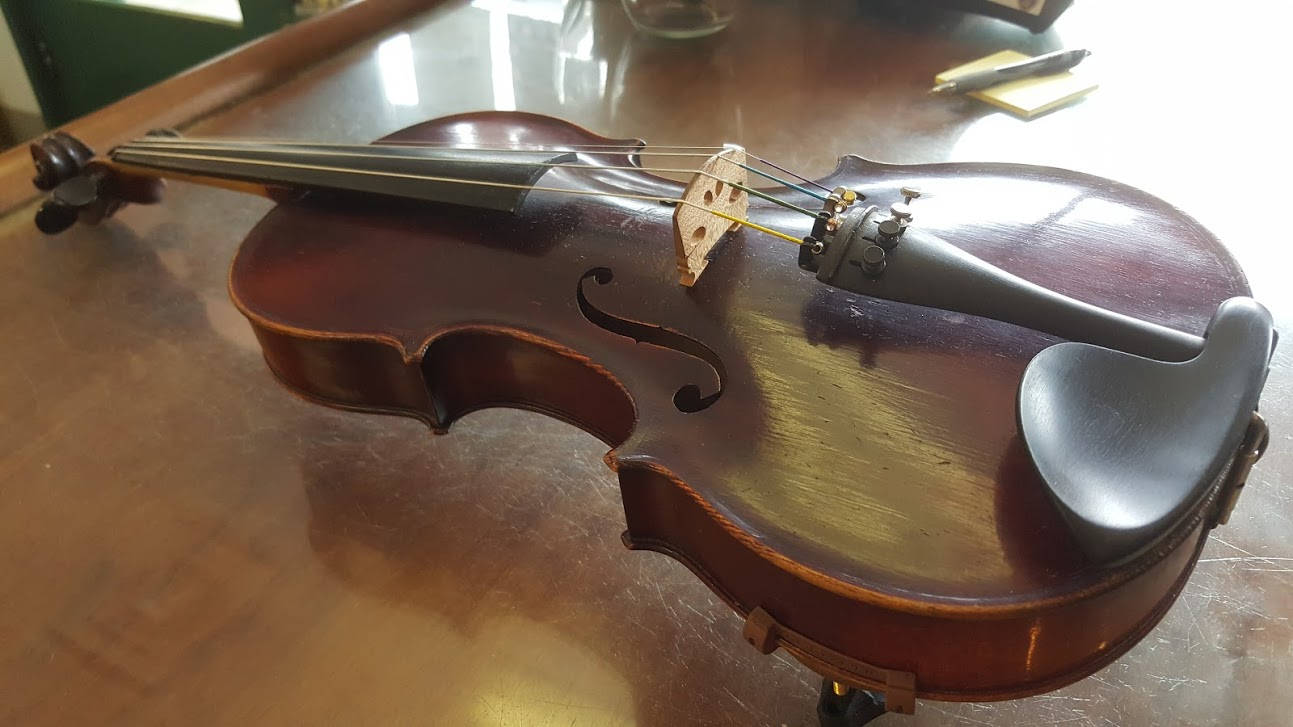
My banjolin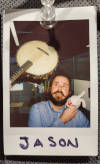 was a spontaneous purchase from the Olde Town Pickin' Parlor. I went in on a whim to chat with Liz and play their mandolins. She said "Look what just walked in the door" and handed me the banjolin. A customer had just brought it in on consignment not five minutes before I walked in and Liz hadn't even moved it off the counter. It's an early 1920's Ditson Victory and it's especially twangy. I bought it then and there, shortly after Liz told me I'd need to put it away before she took it away from me. I often wonder why "banjolin" is the chosen shortened name, implying that the banjo comes first. I think I'd prefer a "manjo".
was a spontaneous purchase from the Olde Town Pickin' Parlor. I went in on a whim to chat with Liz and play their mandolins. She said "Look what just walked in the door" and handed me the banjolin. A customer had just brought it in on consignment not five minutes before I walked in and Liz hadn't even moved it off the counter. It's an early 1920's Ditson Victory and it's especially twangy. I bought it then and there, shortly after Liz told me I'd need to put it away before she took it away from me. I often wonder why "banjolin" is the chosen shortened name, implying that the banjo comes first. I think I'd prefer a "manjo".
Audio Equipment
When I first began recording I used the voice memo app on my cellphone. It's a great tool for taking quick notes, for recording practice, and for seeing how far I've come. I would practice the chords and the melody for a song separately, recording each to my phone and playing the other part alongside it.
Eventually I realized I wanted some way to record into my computer, and the ability to record with a better microphone down the road. I figured out what I wanted: the ability to record into my computer, the ability to connect an external microphone, and the ease of use that I got from using an app on my phone for quick recording. I did some research and made note of what I saw on the desks of my favorite music production youtube creators, and ended up deciding on the Zoom H6 handy recorder. Picking one up new was out of my price range, so I scoured the used markets looking for a deal. I found a person selling one with a few accessories for podcasting and I purchased my first audio interface. The Zoom H6 was a game changer for me. I could record in much higher quality as easily as I could with my phone. I could record directly into my computer over USB. I could wire up half a dozen external microphones or instruments, leaving me room to grow. With a special cable I was even able to wire it into my cellphone to use the external microphones while recording video. I still make use of this recorder on a daily basis - the purchase was money well spent.
With the interface in hand, my next piece of equipment would be a microphone. The seller included three microphones with the H6 - the X/Y mic, a shotgun mic, and a Sennheiser MD 46. While I casually use the X/Y mic for recording, none of them are really suited for recording the mandolin. I asked around for recommendations while saving up for a mic. My good friend Warren managed to find someone selling a used AKG C1000S which I followed through and purchased. Now, armed with my first instrument microphone, I had to learn how to record properly. It turns out that you can't just point a microphone at a sound source and get a good recording. There's an art and technique to it.
A little while down the road I became dissatisfied with the sound of the C1000S. It's a little too bright, a bit too harsh, and not quite as clean as I was hoping. All my research pointed me towards the Neumann KM-184, but those microphones are so incredibly expensive and I wasn't there yet. For my second instrument microphone I picked up a match pair of Rode NT-5's. They were half the price of one Neumann and the sound quality blew me away. The NT-5's are crisp, clean, transparent, and quiet. They do a great job picking up the mandolin. Having better microphones enabled me to record much better audio and they also helped me improve my recording technique.
I had been recording vocals with the MD-46 but I was never all that impressed with the audio. The MD-46 is a broadcast mic - it's meant to clearly pick up spoken word in noisy environments - and for those purposes it works very well. I had been saving up for a better vocal mic while doing research to figure out what the next best step would be. I record a lot of training videos at my job, and for those videos I use a Shure SM7B. It sounds great and I love it for dialog, but it wasn't quite what I wanted for my music. For a vocal microphone I landed on the Rode K2 after a heck of a lot of research, audio samples, and comparison. I drove two hours from my home in Carmel out to Fort Wayne, Indiana to buy one in person at Sweetwater. My oh my - did I make the right decision. The K2 is a valve microphone, meaning it has a tube in the microphone and it's powered by a beefy external power supply. It needs to warm up to sound its best, so I tend to turn on the power supply and give it ten minutes to a half hour before I start recording. The sound it picks up is transparent and subtly flattering. It's got a warmth, depth, and presence that I didn't know was possible from a microphone. It does a heck of a job picking up the mandolin, too!
The downside to having a large diaphragm condenser microphone is just how much sound they pick up. They'll pick up the room, the reflections, the condenser in the refrigerater off in the kitchen, the construction crew down the block, and any other tiny, otherwise back-of-the-mind sounds you don't normally pay attention to. I've learned that recording encompasses multiple dimensions. First and foremost is the performance - what does the source sound like? Next up is the microphone - how does it pick up the sound, and where is it positioned to hear it? Next up is the interface - how clean are the preamps that the mic is running through, and how much background noise is present? Then there's the room - how well treated is the space the recording occurs in? No wonder recording studios are so expensive!
I upgraded my audio interface to a Universal Audio Apollo Twin mkII. I've been generally impressed with the preamps and the software that runs everything. The plugins are top-notch and fun to experiment with. The ASIO drivers are exceptional with minimal latency and I've been incredibly impressed with how it functions with Ableton. The Windows audio drivers, on the other hand, are atrocious. If I'm doing a video call, I can't use the microphones wired through the Apollo. It sounds like it was run through a bitcrusher and a blender. If I try to record a video using the Apollo as my audio input the resulting audio is absolute garbage. The manufacturer's suggestion is to run the line out from the Apollo through another audio interface that has proper Windows audio drivers - to use a different audio interface in order to record audio in Windows. For the money, I'm incredibly disappointed. You'd think for what they charge for these interfaces they could afford to develop basic Windows audio drivers. Maybe they'll get around to that eventually and change my opinion to the positive. For strictly music production and recording work into a DAW, the UAD ecosystem is exceptional and I've been very impressed. As an overall audio interface with utility beyond the DAW it's hot garbage. I think my money could have been better spent.
When recording and mixing, the headphones I use are the Sony MDR-7506. They're the industry standard and for good reason. They've got a flat frequency response and they present the audio as true as can be. They're incredibly comfortable and I can wear them all day. I've had the same pair for years and I'd buy them again in a heartbeat.
Video Equipment
text
Table of Contents
- Journal
- Daydreams and Circumstance
- Coherence and Context
- Neuroscience and Consciousness
- Searching and Optimization
- Organics and Adaptation
- Struggles and Righteousness
- Privacy and Capitalism
- Dollars and Sense
- Friendships and Entanglement
- Separation and Rebuilding
- Division and Rhetoric
- Reboot Progress
- Considering a reboot
- Contact